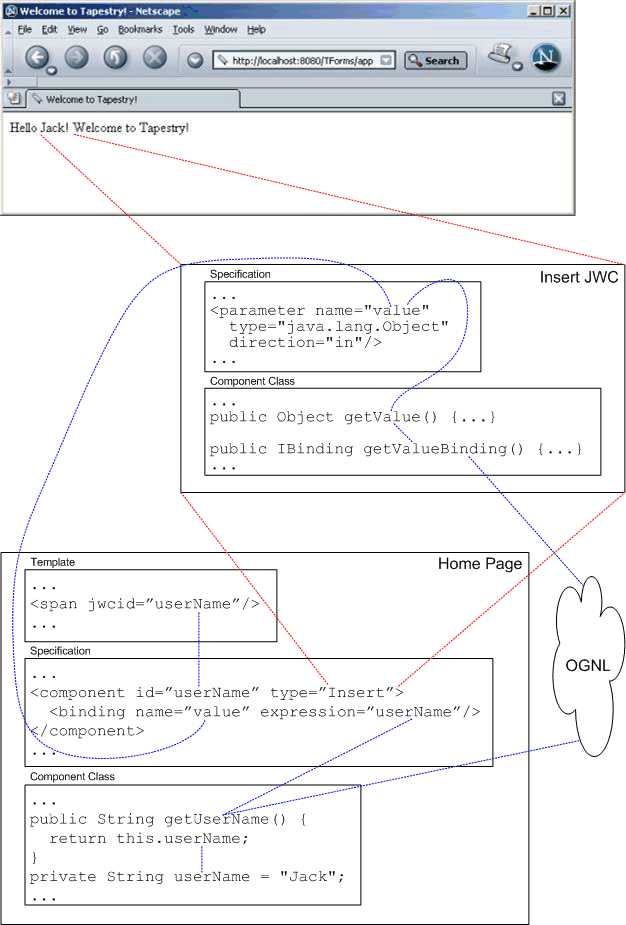Illustration 1
Page Template
-Page Specification
Page Class
Application Specification
web.xml
Page Specification
Listing 2. Home.page<?xml version="1.0" encoding="UTF-8"?> <!DOCTYPE page-specification PUBLIC "-//Apache Software Foundation//Tapestry Specification 3.0//EN" "http://jakarta.apache.org/tapestry/dtd/Tapestry_3_0.dtd"> <page-specification class="demo.Home"> <component id="user" type="Insert"> <binding name="value" expression="userName"/> </component> <context-asset name="$template" path="Home.html"/> </page-specification>
The specification is the part that drives a component and ties its pieces together. It specifies, among a lot of things, the class that defines the behavior of the component under construction (called container or parent component – Home Page in our example), the template for the container component and the components to be plugged in place of the template's placeholder tags (called contained or child components). The defining class (also known as component class –demo.Homein our example) of the container component is specified using theclassattribute of the specification root element –page-specification. The container component's template is specified using thecontext-assetelement. A component can have any number of types of assets (images, stylesheets etc.) associated with it and the template is treated as one such type. The template asset is specified using the special name$template. The contained components are declared using thecomponentelement. Components thus declared are known as an "Explicit" or "Declared" components. Theidattribute of thecomponentelement is like an Object reference in OO paradigm, and is the same as thejwcidattribute of the placeholder tag in the template. Thus the framework knows which component needs to be plugged into which placeholder tag. The type of component to be instantiated and plugged in is defined by thetypeattribute of thecomponenttag. The component we use in our example is theInsertJWC that comes with Tapestry's core library. As mentioned before, every component serves a specific purpose and so is ourInsertJWC. TheInsertJWC, like the name suggests, inserts text (the user name in our example) in place of the placeholder tag in the template. The text to be inserted is provided to the JWC via a parameter defined by the component.
Parameters are the gateway to configure components in Tapestry. Component parameters are like method parameters, the difference being that component parameters can be two-way; i.e., component parameters can pass in a value and also spit out a value. Tapestry allows four different kinds of parameters -in, form, customandauto.inparameters can only pass in a value to the component, while the other kinds can pass values in and out of a component. The value passed in to a component is stored in the JWC as a JavaBeans property (known as parameter-property) in the component class. The value passed out of a component is updated in the variable that was the source of the data that was passed in. This variable is usually an attribute of the container component class, although it can be any variable accessible from the container component class. In addition to the parameter property, the JWC houses another JavaBeans property called the binding-property. Every JWC parameter-property is accompanied by a binding-property. The name of the binding-property is the name of the parameter-property + the literal suffixBinding. The purpose of the binding-property, like the name suggests, is to bind a foreign object (unknown at the time of component definition) to the JWC parameter-property. This allows a JWC to be decoupled from the source of data for the parameter-property. This decoupling is achieved with the help of another incredible open source project – Object Graph Navigation Library, OGNL. The component class will use the parameter-property, via the JavaBeans-stylegetmethod, as needed in defining the component's behavior. Theget<ParameterProperty>method in turn, will use theget<ParameterProperty>Bindingmethod, which will retrieve the bound object at runtime, using OGNL, and make it available to the component class as shown in Figure 2. The parameter-property is specified in the JWC specification at the time of component definition and the binding-property is automatically created and provided by the framework at runtime. The actual binding of the foreign object, though, is specified at the time of component declaration in the container component's specification as shown in our Page specification (Listing 2).

Figure 2. Parameter mechanics
The binding is specified in the component declaration using thebindingelement, nested within thecomponentelement. Thebindingelement has two attributes –nameandexpression. Attributenamespecifies the name of the parameter and theexpressionattribute specifies the foreign object to bind. The foreign object is any object that can be accessed from within the container component class via a JavaBeans-stylegetmethod, or an object that is the result of an OGNL expression. The target foreign object can be a very distant object in the object graph and yet be accessed from right within theexpressionattribute. This object graph navigation is achieved via OGNL. Please see Resources for information on OGNL expressions.
TheInsertJWC (userin our example) defines a parameter calledvalue. This parameter is bound to the foreign object (userNamein our example) via thebindingelement as shown in the example Page specification (Home.page). At runtime, theuserinstance JWC reads the value ofuserNameattribute ofdemo.Homeinstance and updates thevalueparameter using OGNL. Theuserinstance then uses the parameter value and inserts it into the template.
Page components are special JWCs, as already stated. Page components are root level components (can never be contained components) with special attributes and responsibilities. Page components cannot be used as building blocks to compose other components; that said, parameters are useless in Page components and so the framework forbids Pages from having parameters.
The naming convention for specifications is the name of the component with an extension of.page(for Page components) or.jwc(for non-Page components). And thus the specification for our Page component is namedHome.page. Specifications are typically placed under theWEB-INFfolder of the application context. So, ifWelcomeis the context of our Welcome application,Home.pagewill typically be placed underwebapps/Welcome/WEB-INF.
| << Previous | Next >> |